| For the year 2017, the Ministry of Culture, Sports and Tourism announced a list of 10 travel destinations and itineraries covering spots all over the country, with cultural heritage sites, food and accommodations listed at each location.
The ministry has chosen Danyang, along with its neighbors Jecheon, Chungju and Yeongwol, as tourist destinations for people looking to find peace in nature. Here, travelers will find pristine natural sites that offer a getaway from the bustle of city life. |
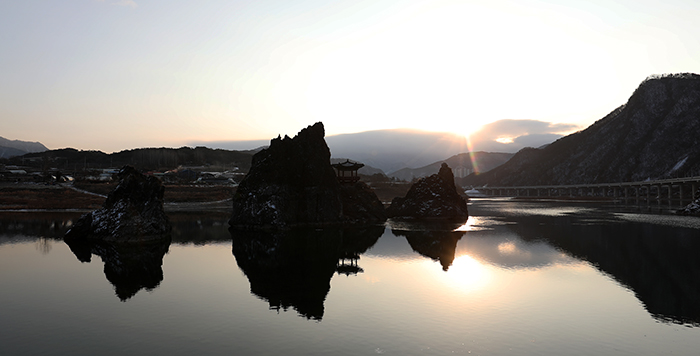
The morning rays of sunlight illuminate the Dodamsambong Peaks (도담삼봉) as a matching silhouette is reflected on the surface of the Namhangang River, on Jan. 13.
It is said that in the days of Joseon, Confucian seonbi scholars spent their free time traveling across the country, visiting scenic spots along the way. Arriving at an especially beautiful location, the men would write poetry and paint pictures as memorabilia from their trip.
Danyang in Chungcheongbuk-do Province happened to be one of these places frequented by the gentry. It was so well-known that Joseon's King Jeongjo (정조, 正祖) (1752-1800) sent Kim Hong Do (김홍도, 金弘道) (1745-1806), one of the most celebrated artists at the time, to Danyang to paint the attractions of the region. Kim spent around three years in the region, starting in 1791, to paint pictures of the landscapes of Danyang, as well as neighboring Cheongpung, Jecheon and Yeongchun.
Flash forward some 200 years and Danyang still remains one of the most pristine and beautiful areas in the land. This year the Ministry of Culture, Sports and Tourism chose Danyang, along with its neighbor Jecheon, as the perfect tourist destination for people looking to find peace in nature.
The modern day Dangyang, shortened from its old name Yeondanjoyang (연단조양, 鍊丹調陽), means, "where sinseon, or Taoist hermits with miraculous powers, govern the land." With its meandering rivers and striking mountain ranges, Danyang offers many attractions that tell some age-old stories.
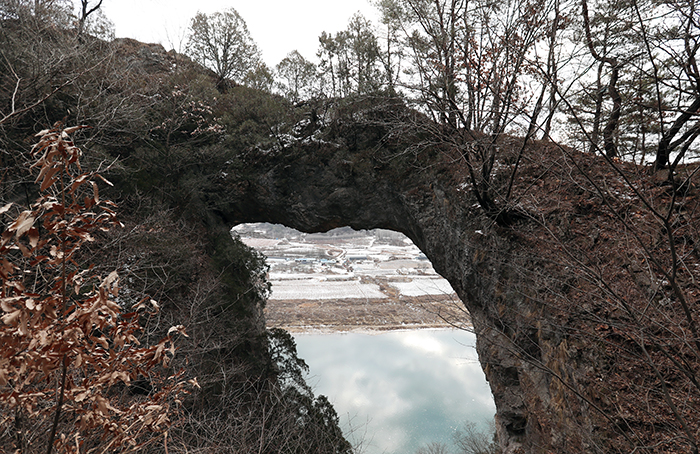
Following the steps leading up from Dodamsambong Peak (도담삼봉), travelers arrive at the Seokmun Gate (석문), a natural stone arch that offers a view of the Namhangang River and nearby villages below.
One of the most famous spots in Danyang are the Dodamsambong Peaks (도담삼봉, 嶋潭三峰), found in the meandering bend of the Namhangang River.
These three peaks are the source of a legend involving "Sambong" Jeong Do Jeon (삼봉 정도전) (1342-1398), a historical figure who helped Taejo, the first king of Joseon, overthrow the Goryeo Dynasty and launch the new Joseon era. He's credited as the principal architect of Joseon policies and of laying down its ideological and institutional framework.
"The story goes that a long time ago, a huge flood swept the entire Sambongsan Mountain, which originally stood in Jeongseon, Gangwon-do Province, into the river basin of Danyang. Officials from Jeongseon, claiming the three peaks in the river belonged to them, began collecting taxes from the people in Danyang each year," said Kim Choon Yun, a provincial tour guide. "Luckily though, a young Jeong Do Jeon, who had spent his childhood days in Danyang, came up with a solution to this problem. Addressing Jeongseon's officials, the boy claimed that the three peaks in the river were a nuisance to waterways and welcomed Jeongseon to take back their precious mountain. After that day, Jeongseon gave up trying to collect taxes altogether," she said with a smile.
As you may have guessed, the three peaks in the story refer to none other than the Dodamsambong Peaks. To this day, visitors can see a statue of "Sambong" Jeong Do Jeon watching over the peaks from his seat by the riverside.
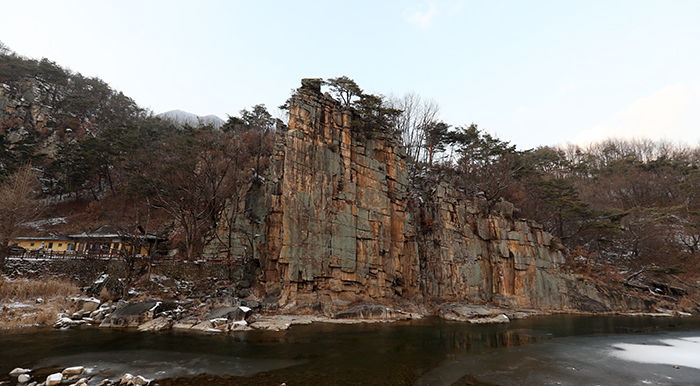
The Sainam Cliff (사인암) tower over the banks of the Namjocheon Stream in Danyang, Chungcheongbuk-do Province, in all their majestic beauty.
As mentioned, another famous Joseon figure that passed through Danyang's picturesque landscapes is the painter Kim Hong Do. The artist is said to have spent a full year trying to capture the Sainam Cliff (사인암) on his paper canvas. It seems that the location was a hot spot among Joseon gentry, as one can easily spot engravings on the cliff face that read like a kind of guest book of short verses. Down by the smooth rocks at the foot of the cliff, there is a flat rock marked like a chessboard, where scholars, it is believed, spent afternoons engaging in games of janggi, or Korean chess.
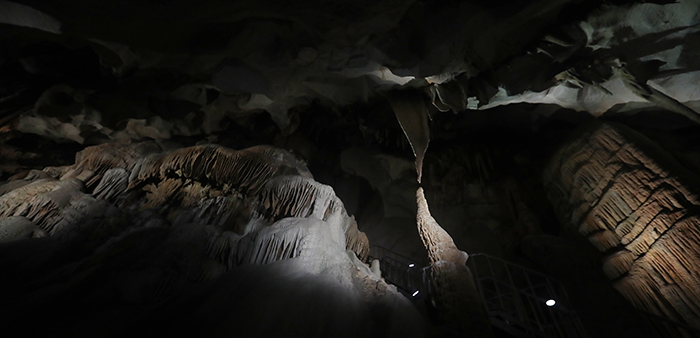
Danyang's Gosudonggul Cave (고수동굴) unveils some 1.7 kilometers of limestone pillars formed in the underground tunnels over thousands of years.
The wonders of Danyang continue deep into the belly of its underground tunnels.
Another must-visit spot in Danyang is the Gosudonggul cave (고수동굴), where visitors will find exotic landscapes created by the chemistry of rainwater and limestone over many centuries. Danyang is home to over 200 caves, but the Gosudonggul cave, extending for some 1.7 kilometers, is one of the county's finest.
Stepping into the caves from the biting chill of January's snow storms, visitors will notice the temperature slowly rise to a comfortable 15 C. According to the tour guide, the Gosudonggul Caves maintain this temperature all year round, making it all the more popular during the freezing winter and the hot summer.
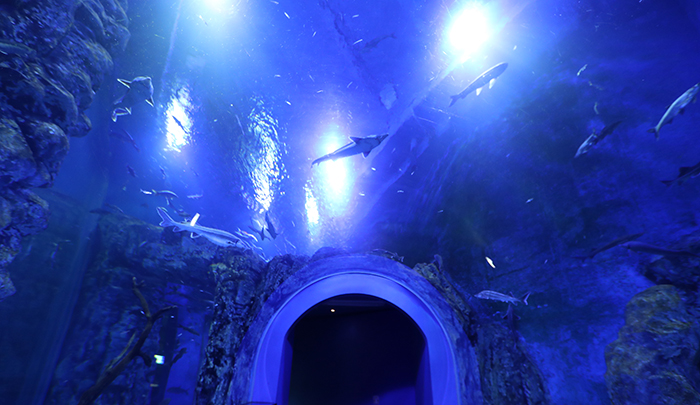
The Danuri Aquarium in Danyang, Chungcheongbuk-do Province, is one of the largest freshwater aquariums in Korea. In addition to the Mandarin fish, the county's mascot fish, visitors will find some 90 different varieties of fish in these tanks.
Finally, the Danuri Aquarium is the place to go if you're traveling with young children, or if you're looking for a few relaxing hours. A giant Mandarin fish statue, located by the entrance, invites visitors to come and explore one of the largest freshwater aquariums in all of Korea.
In addition to the Mandarin fish, the county's mascot, the aquarium is home to some 90 different species of freshwater fish, including the Korean spotted barbel, the Manchurian trout, the catfish and the carp. Conveniently located by the express bus terminal, the aquarium is an ideal place to visit to bookend your visit to Danyang.
By Lee Hana
Korea.net Staff Writer
Photos: Jeon Han, Korea.net Photographer
hlee10@korea.kr
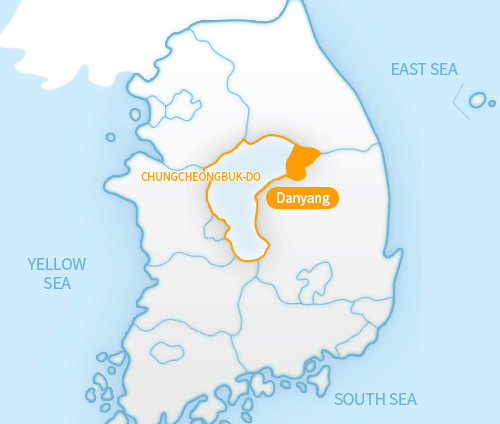
Danyang-gun County is located in the northeast of Chungcheongbuk-do Province. To Danyang's west lies Jecheon, while to the north lies Yeongwol-gun county in Gangwon-do Province. The city of Yeongju and Mungyeong, in Gyeongsangbuk-do Province, can be found on the other side of Danyang's Sobaeksan Mountain range.